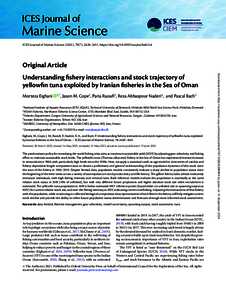Document
Investigations on the reproductive biology and diet of yellowfin tuna, Thunnus albacares, (Bonnaterre, 1788) in the Oman Sea.
Identifier
DOI: 10.1111/jai.12907
Contributors
Kaymaram, F., Author
Publisher
Blackwell.
Gregorian
2016-04
Language
English
English abstract
In this paper, the examination of some reproductive features and stomach contents of yellowfin tuna, Thunnus albacares, were determined by samples taken from Iranian drifting gillnets in the Oman Sea in the years 2007 to 2009. The male to female ratio in overall size was 1: 0.93, which was not significantly different from the expected value 1: 1. Fish lengths ranged from 37 to 152 cm, averaging 78.5 cm for females and 79.2 cm for males. At a larger size (>117 cm) males were proportionally predominant. Length at first maturity, Lm 50%, was observed when females reached 77.2 cm. Data from maturity stages indicated a single spawning period, peaking in May-June, corresponding with a drop in the Gonadosomatic Index (GSI). Fishes were the main prey group, comprising 47.6% of total numbers among the three food item categories in the tuna stomachs. Among the 12 families identified in the stomachs, the Portunidae swimming crab crustacean was the most important prey organism (18.7% of total numbers). A wide range of prey species found in yellowfin tuna stomachs reflects an opportunistic feeding behaviour restricted by local prey availability. Considering the scarcity of available data, the results of the present paper will provide a reference for better knowledge of the biological features of T. albacares in the Oman Sea.
Member of
ISSN
0175-8659
Resource URL
Category
Journal articles


